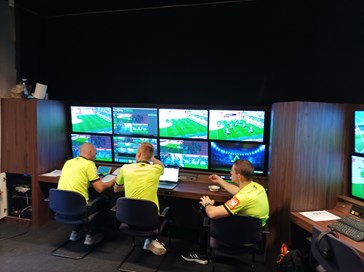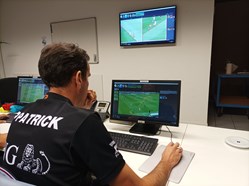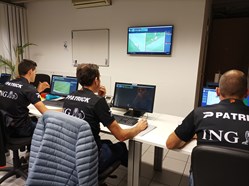Success Story - 3D Virtual Offside Line makes its debut in the Belgian Pro League
Thursday, December 16, 2021

After 2 months using the 3D virtual offside line in Belgian Pro League football matches, we met Stephanie Forde, Operations Director at the Refereeing Department at the Royal Belgian Football Association. Stephanie is one of the few women to hold a leading position in the Belgian professional football and we had a great chance to ask her about the 3D virtual offside line implementation and about the future.
What was the biggest challenge for the Pro League with the implementation of the 3D offside line technology?
The main challenge was to make sure that everybody would be able to effectively use the 3D virtual offside line during live matches. We only had a short timeframe between the training of the VAR replay operators and the live Pro League matches using the 3D line.
The other biggest challenge was not having any experience but that was compensated by the additional support we received from DELTACAST. They assisted us with on-site support during the first two matchdays to cope with any additional issues that might occur.

What does the use of 3D technology bring to the offside line today?
Today, there is a grey zone with the 2D line to determine if a player’s body part - typically head, shoulder of a player - is offside or not.
With the 3D line, it’s more black and white. The 3D virtual offside line provides a scientific result that determines whether a player is onside or not. There is no guess and no human interpretation anymore. An offside position, technically, is black and white if you are talking about the player’s position. With this new technology we can assess 95% of all offside situations correctly.
“The 3D virtual offside line provides a scientific result that determines whether a player is onside or not. There is no guess and no human interpretation anymore
What feedback did you receive regarding the use of this 3D offside line?
The training was important. Especially since the number of steps that is required to conduct before being able to draw the 3D offside line is significant more.


The most important thing is the follow-up given, in continuity with the training. We have created a users' group on “WhatsApp” where we share with DELTACAST the changes that could be made for an optimal use. The practice and use of the system by the VAR operators over time allows the tool to be continually improved.
After a first couple of matches, VAR replays operators proposed some changes and DELTACAST solved them very quickly in order to make the process more comfortable for them.
We also asked for a manual/tutorial where all the steps to draw the offside line are fully described. That feedback came instantly so we are very happy with the DELTACAST support in general.
Now, we do need to reduce the time needed for the VAR operators to draw the 3D line. That will be a great asset to us and to the Belgian football in general. Time is of the essence when it comes to determining whether or not there is an offside position.
“Time is of the essence when it comes to determining whether or not there is an offside position.
The 3D offside line had a slow start in the Belgian Pro League, what is your opinion on this?
We always have to be honest in our communication and not blame the system or whatever, and in this case, it was more a human resources problem.
You can have so much training sessions as you like, however, as soon as you go live, and you operate with time pressure, it is of most importance to remain calm.
The solution is that DELTACAST modified the program and put more safety slots for the operators to avoid the same problem in the future again.
It is also why we have implemented a step-by-step procedure that is available on each operator’s desk at every match so that when they have to draw a 3D line and feel pressured in time, they can relax, look at the procedure and just follow it accordingly.
“You can have so much training sessions as you like but as soon as you go live, and you operate with time pressure, it is of most importance to remain calm.
How does the future look like for the Virtual Offside Line?
We will always need a human operators for controlling all the camera angles and providing the VAR with the best images. However, we would be able to have an automatic offside line and that would be very fantastic: that would save us so much time during the match!
Nevertheless, we will always need the operators to monitor all the camera’ angles, to determine the penalty situations, faults, red cards, mistakes in identity and so on.

